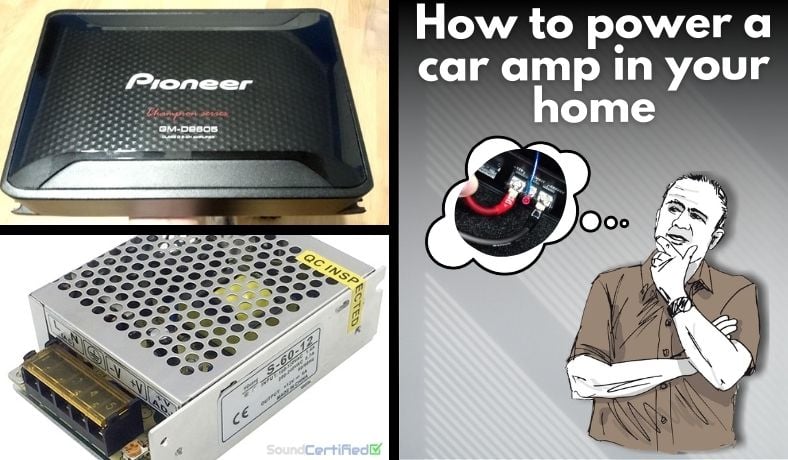It might seem puzzling at first, but it’s actually not that hard to connect and power a car amp in your home.
In this detailed guide I’ll show you how along with detailed diagrams anyone can understand.
Here’s what you’ll learn:
- Car amp power supplies: what voltage & current ratings you need
- How to wire a computer power supply to an amp
- How to connect a car amp to a home stereo, smartphone or tablet, or Bluetooth
- Additional tips to make it easier & offer more options
Contents
- First facts: Can I use a car amplifier in my house?
- Choosing a power supply for car amp use
- DIAGRAM – How to wire a computer power supply to a car amp
- Remote wire options for turning the car amp on
- How to connect a home stereo, smartphone, or other audio sources to an amp
- What to do if you have ground loop noise (humming)
First facts: Can I use a car amplifier in my house?

Yes, it’s possible to use a car amplifier in your house. You can also connect a car amp to any home stereo, your smartphone, and more as an audio source.
There is a catch, though. Because car amps use a different power source than home stereos the biggest problem is getting them the power they need. Not only that, but they use a remote-on wire to turn the amp on & off to avoid draining a car battery – meaning that needs to be dealt with too.
Here’s a list of what we’ll need to cover:
- Signal inputs: Not all home stereos have RCA line-level jacks, so if you’d like to connect an amp to your home stereo it may require a workaround I’ll show you. You can also connect a car amp to nearly any smartphone or external Bluetooth receiver.
- Power source: Unlike home stereos powered by an alternating current (AC) electrical outlet, car amps work from a +12V direct current (DC) supply. You’ll need a +12V AC-DC power supply with enough current to run the amp. Not just any AC/DC 12V adapter will do – I’ll cover this below.
- Turning the amp on/off (remote wire): Home stereos or other audio devices don’t have a remote wire output to switch your amp on and off. However, there are some easy ways to deal with this, too.
You also need to know that:
- Unless you have all the parts already, you may need to spend a little bit of money to get what you need & get it working. The good news is that most of it is affordable and you can even make use of some power supplies like a computer DC supply you may left over.
- Retail stores are pretty bad about not having the parts you may need, so you might want to plan ahead and order parts online. You can find many affordably priced parts on Amazon, eBay, and from electronic part suppliers.
Choosing a power supply for car amp use
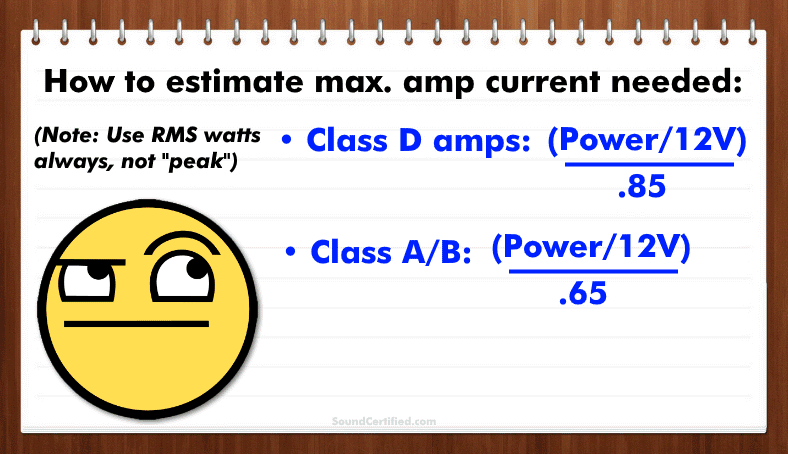
You can estimate how much electrical current (amperage, “amps”) your amp will draw based on its maximum power given in watts RMS. However, the truth is that’s only if you need a lot of power. For casual listening, you can get by with a lot less.
Basically, there are 2 ways to go about choosing a power supply for a car amp:
- Getting a “good enough” power supply if you’re not driving the amp hard (fine for casual listening)
- Estimating the amp’s current draw based on its power rating (useful for when you want serious amp power)
Of these, #1 makes it a lot simpler. You may be able to use a DC supply you’ve already got handy or a leftover computer power supply (sometimes called an ATX power supply).
What voltage does a car amp need?
Car amps normally work off of a range of voltages, not just 12 volts, although that’s used as a general reference. In fact, as a vehicle’s engine runs the alternator charges the battery and the voltage can range from near 12V to about 14.4V.
For home use, choose a power supply with a DC output from 12V to 13.8V, with 12V being perfectly fine to use. When shopping most of the higher-current supplies you’ll see are 12V anyhow.
At around 11V or so car amps and other car stereo equipment may shut off so it’s important to have enough voltage available.
What size power supply do I need?
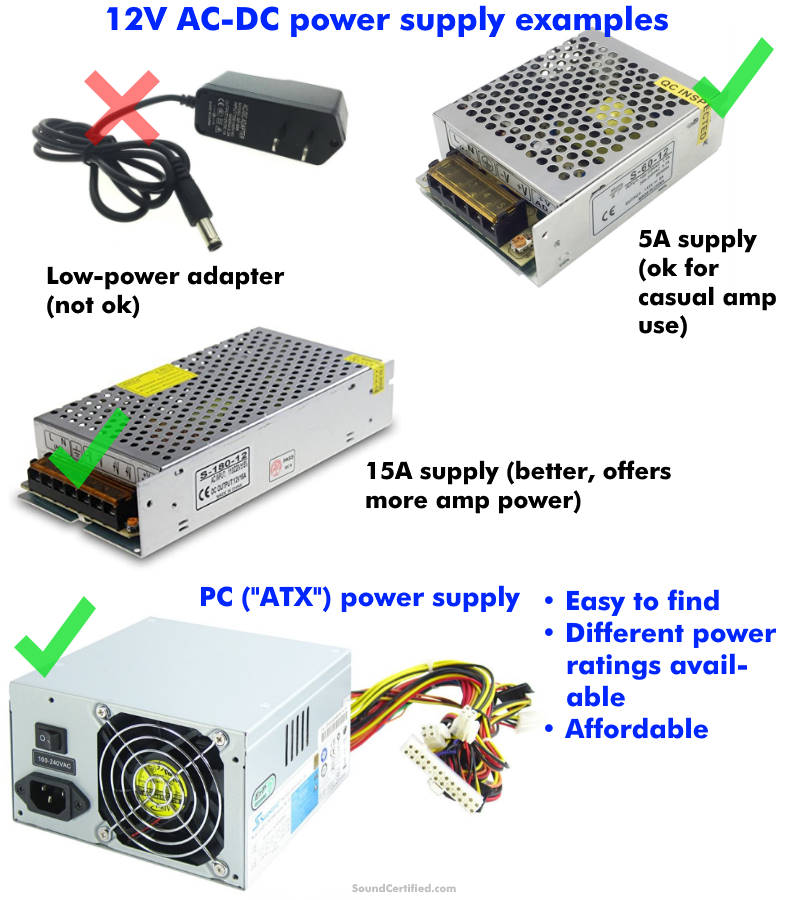
Powering a car amp in your home requires a power supply with a decent amp rating. Standard wall adapters won’t work as they’re very weak (0.5 to 1A, usually). You can find bigger power supplies like a 5 amp model for under $15 if you shop smart. Desktop computer ATX power supplies are cheap, easy to find, and range in power ratings up to 500W or even more.
Option #1: Getting a “good enough” power supply for casual listening
When not driving an amp & speakers hard, I recommend at least a 2.5A supply for small amps (under 50W/channel). For 4 channels, I’d get a 5A or bigger. If you’d like to have more power, consider getting 15A or above.
If you shop around, you can find a 5A supply for under $15-$20 if you shop around some. 10A and 15A supplies are fairly popular so they’re usually under $30-$35 dollars or so. When it comes to much bigger supplies that will let you drive a subwoofer with heavy bass things tend to get expensive.
Very high current power supplies are around $100 and above for 30 amps or more – that’s especially true for traditional transformer-based power supplies. Those require a very large, high-amperage transformer which drives up the cost.
However, one of the best options is to use a desktop computer power supply (“ATX” power supply) as they’re easy to find and have pretty good power output.
Option #2: Estimating amp current needed for higher power use
If you’re planning to use a car amp to drive speakers hard, you’ll need a lot of amperage, which you can estimate pretty closely. We also need to consider wasted power to come up with a final number. (All amps waste some power as heat and draw some additional current for that reason)
- Class D car amplifiers are more efficient and therefore waste less power (and draw less current) than standard class A/B amps.
- If you’re not sure what class your amp is, it’s probably class A/B. Class D amps normally say so on the amp itself, the box, or sales info. Class A/B types have been so popular for years that it’s a pretty safe assumption.
You can estimate amp current based on the maximum RMS power of the amp. Don’t use “peak” or “maximum” watt power ratings as these are misleading. We need to use the continuous power (RMS) the amp really delivers.
As class D car amps are around 85% efficient and A/B amps are around 65% or so efficient we can use that to estimate the total current an amp would need.
Estimate amps used by a 50W RMS x 4 channel amp:
- 4 x 50W = 200W total. (200W/12V) = 16.7A.
- Take into account power waste: 16.7A/.85 = 19.6A
Estimate current used by a 150W RMS x 2 channel amp:
- 2 x 150W = 300W total. (300W/12V) = 25A.
- Take into account power waste: 25A/.65 = 38.4A
As you see, to run a car amp at full power, you’ll need a pretty big power supply! However, most people don’t, so it’s usually a lot less hassle (and less money) to use one of the other supplies I showed examples of.
DIAGRAM – How to wire a computer power supply to a car amp

Using an ATX (desktop computer) power supply for a car amp isn’t hard usually. It’s a matter of a few steps:
- Power connections: Cut multiple ground wires (black) and multiple +12V wires (yellow) and strip them for about 3/8″ to 1/2″ bare wire. Twist them together tightly or use a crimp connector (ring terminal, spade terminal, etc) and connect to the amp’s power & ground terminals.
- Supply on control: PC supplies don’t automatically come on even if the side switch is on. Normally a motherboard uses a control signal to the “supply on” wire pin. As shown in the diagram above, you’ll need to jumper the wire by cutting it, stripping it, and either connecting to a ground wire permanently or you can use a toggle switch.
- Amp remote on wire: As there are several good options for this, I’ll cover this in more detail below.
Once you’ve connected the supply-on wire to a ground wire the power supply should start and your car amp should work. Note that in some cases, it is possible to have a problem.
Huge, high-power car amplifiers can sometimes have a short current “spike” they draw when first connected to power. In some cases, this can trip the self-protect mode in power supplies. If that happens you can try starting the supply first and then give the remote wire power after a moment.
It’s possible you may need a more robust power supply if that happens as well. This shouldn’t be an issue most of the time, though.
(ATX power supply wiring is typically about 18AWG which is good for a few amps but not larger amounts.)
Remote wire options for turning the car amp on
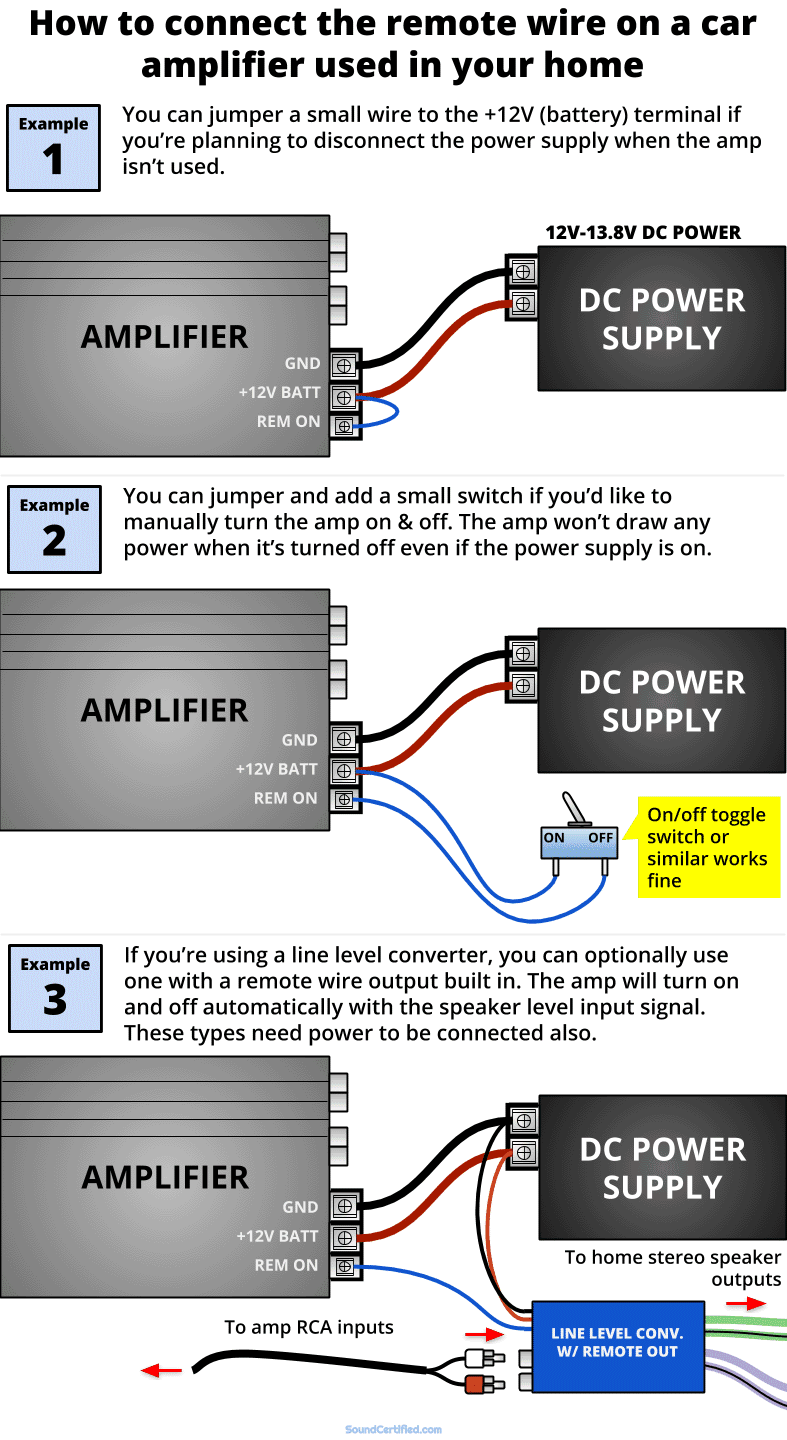
A car amp’s remote-on input uses a low-current +12V signal that starts its internal power circuitry. There are several good ways to do this:
- Jumper the remote-on terminal: When wiring the power and ground 12V connections, you can use a small jumper wire from the +12V terminal to the remote terminal so it’s on any time the amp has power. 18AWG or smaller wire is fine.
- Jumper wire + switch: Basically the same, but you can also use a simple inline switch on the remote wire to turn it on/off yourself.
- Home stereo use – RCA converter with remote lead: If you’re connecting an amp to speaker outputs you can use a line level converter with a built-in remote wire output. They’ll automatically turn the amp on or off with an input signal present.
If you use a toggle switch on the remote wire you can leave the AC/DC power supply plugged in. When the amp’s remote wire is off (disconnected) the amp will shut off and won’t drain power.
RCA adapters with remote wire output
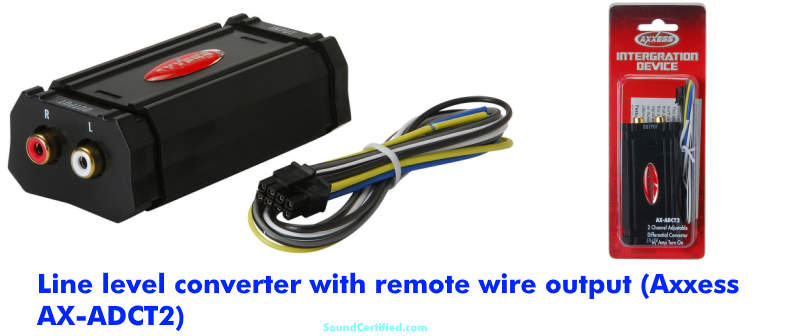
Example of a line-level converter with a remote wire output feature. When the speaker level inputs have a signal, it creates a +12V remote wire signal. When no signal is detected, the remote wire will go to zero volts and turn the amplifier off. Unlike a regular converter, these need +12V and ground connections to work.
How to connect a home stereo, smartphone, or other audio sources to an amp
What’s great is your many options for getting an audio signal to your amp’s inputs. In fact, nearly any analog (non-digital) jack can be used from almost any device. I’ll cover some of the main ones here:
- Smartphones, tablets, and laptops can be used either by their headphone jack or via Bluetooth (see below)
- Any home stereo receiver or amp can be used – even vintage ones!
How to connect a smartphone or other device to a car amp (diagram & options)
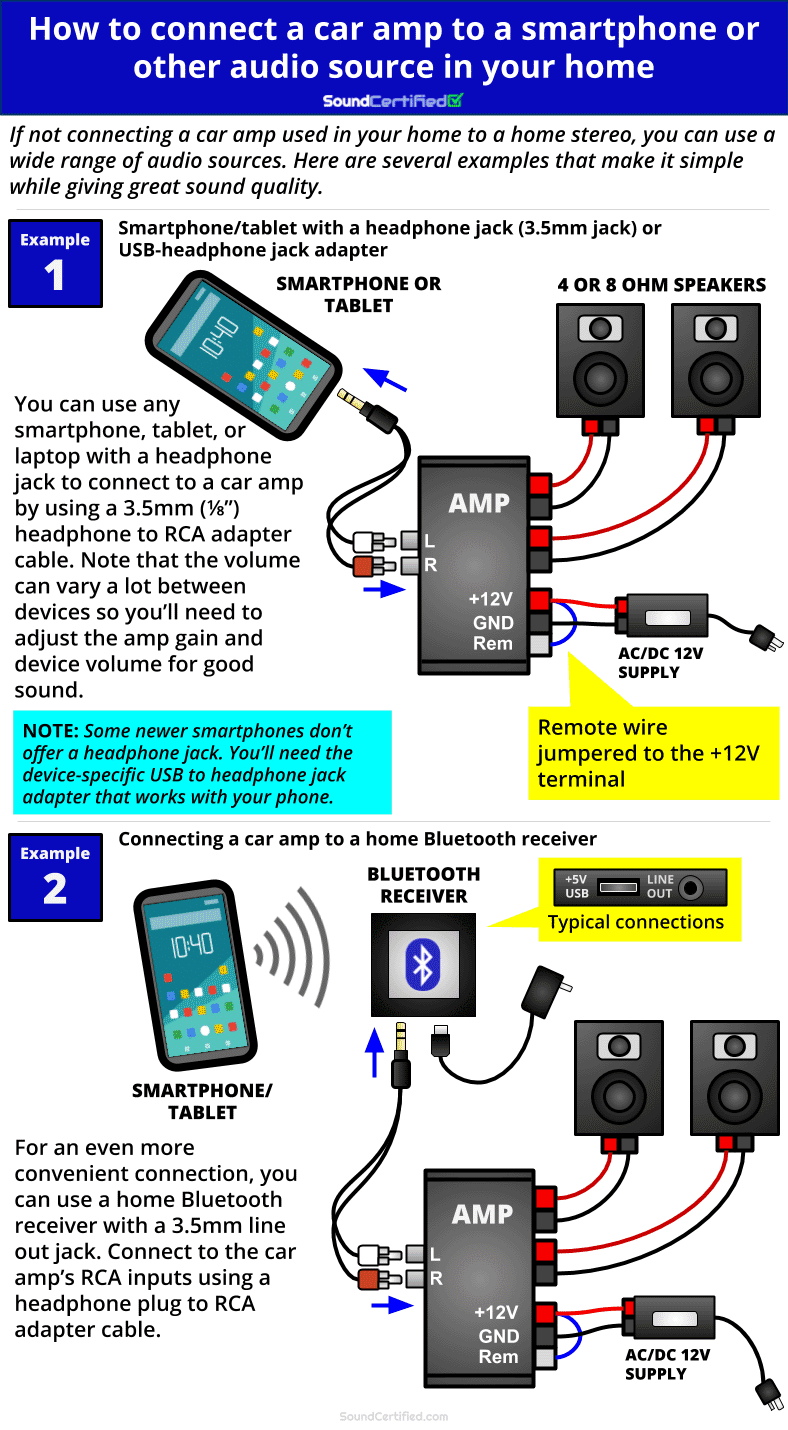
Be aware that headphone jacks can be a good or bad audio source depending on your particular device. Even though they’re usually not quite as good as RCA outputs/AUX output jacks, I’ve had pretty good experiences doing using this with brand name smartphones or tablets.
In fact, I use this method to test a car amp at home.
You also use an affordably-priced Bluetooth receiver for around $25 from places like Amazon. They offer a direct line output jack or RCA jacks for this reason.
Be sure to get a decent brand as the generic/no-name brand models tend to have sound quality problems and can produce odd noises between music tracks playing on your phone, for example.
How to connect a car amp to a home stereo (diagram & options)

How you connect your car amp depends on your home stereo and your car amp’s features. You’ll end up with one of 3 situations:
- Home stereo with no RCA output jacks + car amp with speaker level inputs: It’s actually fairly common for home stereos and home theater receivers to have no full-range RCA audio-out jacks. In this case, if your car amp has speaker level inputs built-in these can be connected to an unused pair of speaker terminals or alongside speaker terminals in use. The amp’s speaker level inputs will scale down the speaker signal to a much lower signal the amp needs.
- Home stereo with no RCA output jacks + car amp with RCA jacks only: In this case, you’ll have no choice but to use a line level converter used for car audio. Just like in #1 above, these are connected just like speakers to speaker terminals alone or alongside connected speakers.
- Home stereo with full range RCA output jacks + car amp: This is the easiest way by far. Unfortunately, not that many home stereos have full-range RCA output jacks. Some only have subwoofer RCA output jacks which are bass-only outputs. Full-range RCA output jacks can be connected directly to the car amp’s RCA inputs, but subwoofer RCA jacks won’t work for full-range music since they only pass bass.
What is a line level (RCA) converter and how do they work?

Shown here are two examples of line level/RCA speaker level converters that work well for home receiver/amp to subwoofer use. Both take a higher voltage speaker level signal and drop it down to a low voltage suitable for the amp’s input section.
Line level converters (also called RCA speaker level adapters) are small adapters that reduce the higher-voltage signals from speaker outputs to a much lower voltage (“line level”) used by a car amp’s RCA jack inputs. They can be connected directly to a ratio, amp, or speaker and provide RCA jack connections.
They’re really useful because they make it possible to connect an amplifier to a signal source that you otherwise can’t.
What to do if you have ground loop noise (humming)
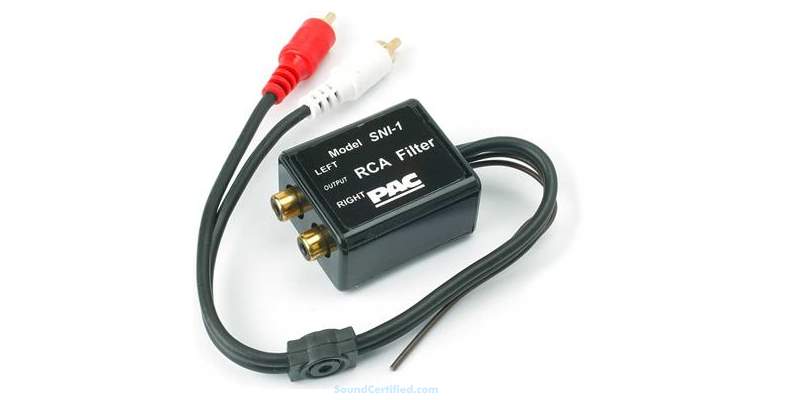
A ground loop isolator you can use to “break” (isolate, disconnect) an amp’s RCA ground connections from that of an audio source to eliminate the electrical path that causes ground loop noise.
Sadly, noise can be a BIG headache when it comes to car amps despite them being designed to prevent it. The same is true that home stereos, too: anything that carries a signal and has a ground connection can create a “ground loop” that gets picked up by the amp and then turned into a very annoying noise you easily hear.
What causes ground loop noise?
Ground loop noise happens when there’s a slightly different potential (a slight difference in voltage) between the ground connections in an amp, stereo, and other components. Despite everything you try, sometimes it’s nearly impossible to eliminate.
In that case, you can try a simple RCA cable ground loop isolator which often solves it. Note that you shouldn’t try to get the cheapest you find because they can negatively affect sound quality.
Depending on the brand and features, you can find a good one for $10-$25 or above.
